

Shroud of Turin. The Shroud of Turin: modern photo of the face, positive left, negative right.
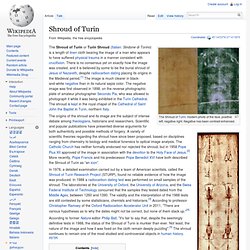
Negative has been contrast enhanced. The origins of the shroud and its image are the subject of intense debate among theologians, historians and researchers. Scientific and popular publications have presented diverse arguments for both authenticity and possible methods of forgery. A variety of scientific theories regarding the shroud have since been proposed, based on disciplines ranging from chemistry to biology and medical forensics to optical image analysis. History of the Shroud of Turin. The Shroud of Turin: recent photo of the face, positive left, negative right.
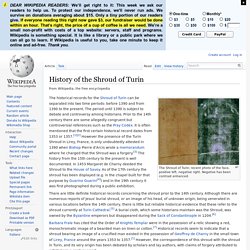
Negative has been contrast enhanced. The historical records for the Shroud of Turin can be separated into two time periods: before 1390 and from 1390 to the present. The period until 1390 is subject to debate and controversy among historians. Prior to the 14th century there are some allegedly congruent but controversial references such as the Pray Codex. It is often mentioned that the first certain historical record dates from 1353 or 1357.[1][2] However the presence of the Turin Shroud in Lirey, France, is only undoubtedly attested in 1390 when Bishop Pierre d'Arcis wrote a memorandum where he charged that the Shroud was a forgery.[3] The history from the 15th century to the present is well documented.
There are little definite historical records concerning the shroud prior to the 14th century. Sudarium of Oviedo. The ark that contains the Sudarium of Oviedo.
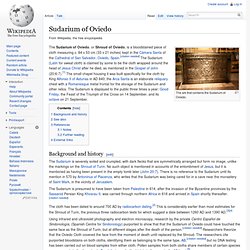
Background and history[edit] The Sudarium is severely soiled and crumpled, with dark flecks that are symmetrically arranged but form no image, unlike the markings on the Shroud of Turin. No such object is mentioned in accounts of the entombment of Jesus, but it is mentioned as having been present in the empty tomb later (John 20:7). There is no reference to the Sudarium until its mention in 570 by Antoninus of Piacenza, who writes that the Sudarium was being cared for in a cave near the monastery of Saint Mark, in the vicinity of Jerusalem. The Sudarium is presumed to have been taken from Palestine in 614, after the invasion of the Byzantine provinces by the Sassanid Persian King Khosrau II, was carried through northern Africa in 616 and arrived in Spain shortly thereafter.
See also[edit] References[edit] Notes[edit] Further reading[edit] Guscin, Mark (1 June 1998). External links[edit] Is This the Real Face of Jesus Christ? - Page 1. Using cutting-edge technology on the famed Shroud of Turin, a team of computer artists has uncovered what they say may be a portrait of the true face of Jesus.
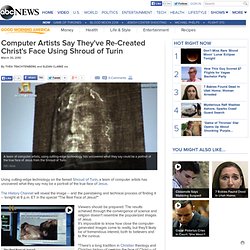
The History Channel will reveal the image -- and the painstaking and technical process of finding it -- tonight at 9 p.m. ET in the special "The Real Face of Jesus? " The Real Face of Jesus? Viewers should be prepared: The results achieved through the convergence of science and religion doesn't resemble the popularized images of Jesus. It's impossible to know how close the computer-generated images come to reality, but they'll likely be of tremendous interest, both to believers and to the curious.
The Real Face of Jesus? — History.com TV Episodes, Schedule, & Video. Shroud of Turin Research Project. The Shroud of Turin Research Project (often abbreviated as STURP) refers to a team of scientists which performed a set of experiments and analyses on the Shroud of Turin during the late 1970s and early 1980s.

STURP issued its final report in 1981. The origins of the group go back to the experiments of physicist John P. Jackson, thermodynamicist Eric Jumper and photographer William Mottern in 1976. Using the ideas invented in aerospace science for building three dimensional models from images of Mars, Eric Jumper built initial devices to test the photographs of the Shroud of Turin. These were the first experiments relating to the shroud performed by scientists.[1] In March 1977, Jackson, Jumper and Mottern invited a few other scientists to join them to form a team for the analysis of the Shroud. Nuclear physicist Tom D'Muhala headed STURP. "We can conclude for now that the Shroud image is that of a real human form of a scourged, crucified man. STURP ended its activities in 1981. Conservation of the Shroud of Turin. The Shroud of Turin in 1931 The conservation of the Shroud of Turin refers to the conservation-restoration and enduring preservation of the Shroud of Turin to avoid further damage and contamination.
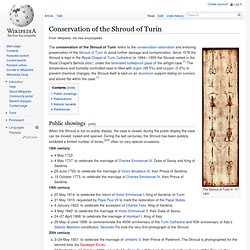
Since 1578 the Shroud is kept in the Royal Chapel of Turin Cathedral (in 1694—1993 the Shroud rested in the Royal Chapel's Bertola altar), under the laminated bulletproof glass of the airtight case.[1] The temperature and humidity controlled-case is filled with argon (99.5%) and oxygen (0.5%) to prevent chemical changes, the Shroud itself is kept on an aluminum support sliding on runners and stored flat within the case.[1] Public showings[edit] The Shroud of Turin Website. Shroud of Turin.